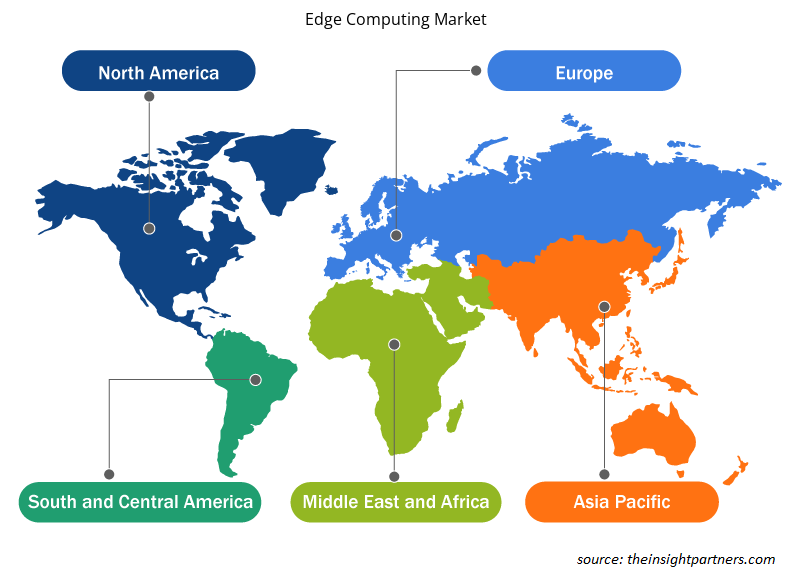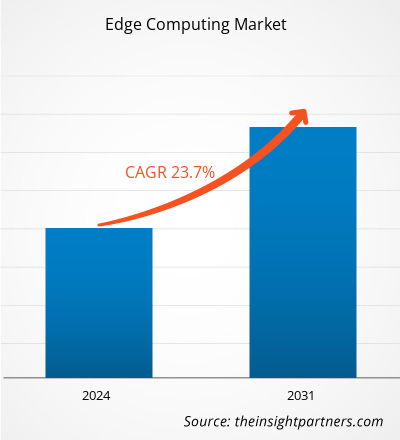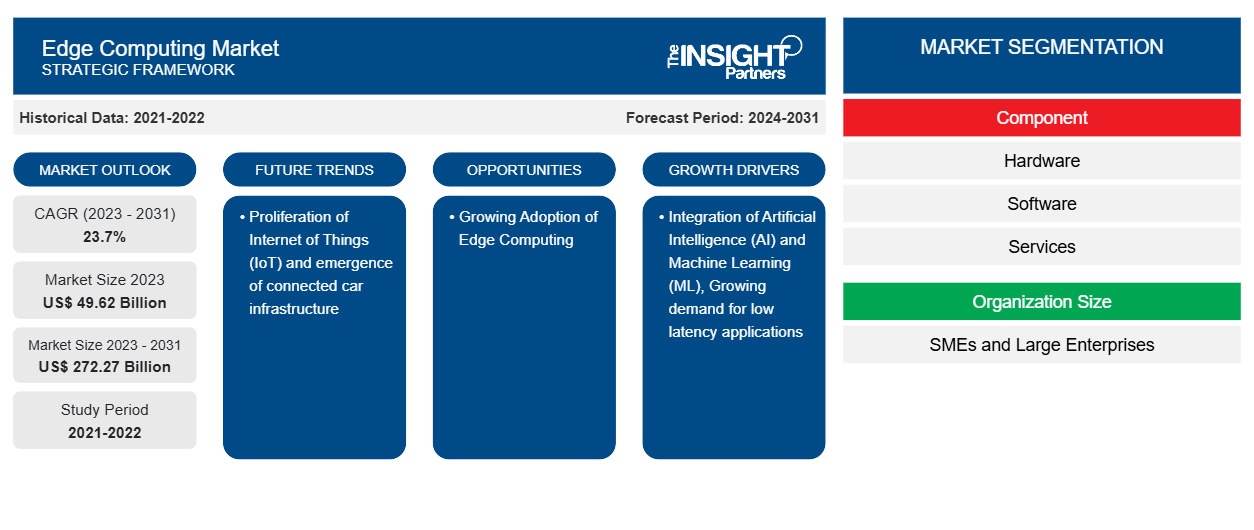Si prevede che il mercato dell'Edge Computing crescerà da 49,62 miliardi di dollari nel 2023 a 272,27 miliardi di dollari entro il 2031; si prevede che si espanderà a un CAGR del 23,7% dal 2023 al 2031. Si prevede che la proliferazione dell'Internet of Things ( IoT ) e l'emergere dell'infrastruttura per auto connesse saranno una tendenza chiave nel mercato.
Analisi di mercato dell'Edge Computing
L'ascesa dell'edge computing rappresenta un cambiamento significativo nel modo in cui elaboriamo e gestiamo i dati. Il suo potenziale di fornire elaborazione in tempo reale, maggiore efficienza della larghezza di banda e sicurezza migliorata ha conseguenze di vasta portata per molti settori. L'impatto dirompente dell'edge computing è evidente in settori che vanno dall'assistenza sanitaria alle città intelligenti e all'industria. L'edge computing si è sviluppato in un'architettura chiave che supporta l'elaborazione distribuita e l'Edge AI. In altre parole, l'edge computing mantiene i dati computazionali e l'archiviazione vicino all'utente, sia tramite rete che distanza geografica. L'elaborazione dei dati può spesso essere eseguita sul dispositivo stesso. Pertanto, si prevede che la domanda di edge computing crescerà durante il periodo di previsione.
Panoramica del mercato dell'Edge Computing
Edge computing è un nuovo paradigma di elaborazione che si riferisce a un set di reti e dispositivi situati presso o vicino all'utente. L'elaborazione edge avvicina i dati al luogo in cui vengono generati, consentendo velocità e volumi di elaborazione più rapidi e maggiori, con conseguenti risposte più fruibili in tempo reale. Edge computing presenta alcuni vantaggi distinti rispetto ai modelli tradizionali in cui la capacità del computer è concentrata in un data center on-premise. Mettere l'elaborazione all'edge consente alle aziende di migliorare il modo in cui gestiscono e utilizzano le risorse fisiche, creando al contempo nuove esperienze umane interattive. Gli scenari di utilizzo dell'edge computing includono, tra gli altri, auto a guida autonoma, robot autonomi e dati di apparecchiature intelligenti.
Personalizza questo report in base alle tue esigenze
Riceverai la personalizzazione gratuita di qualsiasi report, comprese parti di questo report, o analisi a livello nazionale, pacchetto dati Excel, oltre a usufruire di grandi offerte e sconti per start-up e università
-
Scopri le principali tendenze di mercato in questo rapporto.Questo campione GRATUITO includerà analisi di dati che spaziano dalle tendenze di mercato alle stime e alle previsioni.
Driver e opportunità del mercato dell'Edge Computing
Integrazione dell'intelligenza artificiale (IA) e dell'apprendimento automatico (ML) per favorire la crescita del mercato
Negli ultimi anni, l' Internet of Things ( IoT ) ha ottenuto un'accettazione significativa. L'IoT ha accelerato significativamente lo sviluppo dell'intelligenza artificiale (IA) fornendo dati adeguati per l'addestramento e l'inferenza del modello. Con lo sviluppo continuo e l'ampia distribuzione dell'IoT , il cloud computing ha iniziato a rivelare un numero crescente di problemi. Ad esempio, se i dati creati dai dispositivi terminali globali vengono elaborati e archiviati in un cloud centralizzato, ciò causerebbe una serie di problemi, come bassa produttività, elevata latenza, colli di bottiglia della larghezza di banda, privacy dei dati, vulnerabilità centralizzate e costi aggiuntivi. Per risolvere le difficoltà del cloud computing descritte sopra, un nuovo paradigma di elaborazione noto come edge computing (EC) ha riscosso un notevole interesse. Espressa, la nozione centrale del modello EC è quella di spostare i processi di elaborazione, archiviazione ed elaborazione dei dati precedentemente richiesti dal cloud all'edge della rete, vicino ai dispositivi terminali. Ciò riduce i tempi di trasmissione dei dati e i tempi di risposta dei dispositivi, allevia la pressione sulla larghezza di banda della rete, abbassa i costi di trasmissione dei dati e realizza la decentralizzazione. Pertanto, si prevede che l'integrazione di intelligenza artificiale e apprendimento automatico (ML) stimolerà la crescita del mercato dell'edge computing durante il periodo di previsione.
Crescente adozione dell'Edge Computing
Si prevede che l'edge computing avrà un impatto significativo in tutti i settori. Mentre alcuni settori verticali ne hanno già visto l'impatto, altri hanno maggiori probabilità di adottare tardivamente l'edge computing. Negli ultimi anni, aziende di vari settori si sono rivolte all'edge computing per potenziare sia i team di tecnologia operativa (OT) che quelli di tecnologia informatica (IT), supportare applicazioni e dati essenziali per la missione e ridurre i costi. L'edge computing ha recentemente acquisito appeal grazie alla sua scalabilità, alla potente gestione delle analisi e alla capacità di prevenire i tempi di inattività. Gli edge OT sono potenti dispositivi di elaborazione che alimenteranno la fabbrica intelligente gestendo macchine e apparecchiature, concentrandosi su analisi avanzate, manutenzione e realtà aumentata. Dal lato IT, poiché queste applicazioni sono diventate più sofisticate ed essenziali, affidarsi solo ai team OT per gestirle non è sufficiente. Poiché i team IT sono specialisti in governance, gestione e sicurezza dei dati, garantiscono che tutte queste variabili si verifichino all'edge e che le tecnologie scalabili vengano implementate per risparmiare denaro e ridurre i rischi aziendali.
Analisi della segmentazione del rapporto di mercato Edge Computing
I segmenti chiave che hanno contribuito alla derivazione dell'analisi di mercato dell'Edge Computing sono componenti, applicazioni, dimensioni aziendali e settore.
- Based on component, the market is segmented into hardware, software, and services. The hardware segment accounted for the largest share of the edge computing market in 2023, owing to the increasing adoption of IoT-based systems owing to the increase in the number of connected devices.
- The edge computing market, by application, is segmented into smart cities, Industrial Internet of Things (IIoT), content delivery, augmented reality and virtual reality, and others. The smart cities segment is projected to grow at a faster pace during the forecast period due to growing initiatives in the development of smart infrastructure.
- The market, by enterprise size, is segmented into small and medium enterprises, and large enterprises.
- The edge computing market, based on industry, is segmented into manufacturing, energy & utility, government, IT and telecom, healthcare, retail and consumer goods, and others.
Edge Computing Market Share Analysis By Geography
Based on region, the market is segmented into North America, Europe, Asia Pacific, Middle East & Africa, and South & Central America.
Technology advancements such as the Industrial Internet of Things (IIoT), Industry 4.0, and 5G network services, as well as the expansion of the connected device ecosystem, have resulted in massive amounts of data being generated, necessitating the use of a powerful computational infrastructure. This, in turn, is anticipated to boost the growth of the edge computing market in the Asia Pacific region during the forecast period.
Edge Computing Market Regional Insights
The regional trends and factors influencing the Edge Computing Market throughout the forecast period have been thoroughly explained by the analysts at Insight Partners. This section also discusses Edge Computing Market segments and geography across North America, Europe, Asia Pacific, Middle East and Africa, and South and Central America.

- Get the Regional Specific Data for Edge Computing Market
Edge Computing Market Report Scope
| Report Attribute | Details |
|---|---|
| Market size in 2023 | US$ 49.62 Billion |
| Market Size by 2031 | US$ 272.27 Billion |
| Global CAGR (2023 - 2031) | 23.7% |
| Historical Data | 2021-2022 |
| Forecast period | 2024-2031 |
| Segments Covered |
By Component
|
| Regions and Countries Covered |
North America
|
| Market leaders and key company profiles |
|
Densità degli attori del mercato: comprendere il suo impatto sulle dinamiche aziendali
Il mercato dell'Edge Computing sta crescendo rapidamente, spinto dalla crescente domanda degli utenti finali dovuta a fattori quali l'evoluzione delle preferenze dei consumatori, i progressi tecnologici e una maggiore consapevolezza dei vantaggi del prodotto. Con l'aumento della domanda, le aziende stanno ampliando le loro offerte, innovando per soddisfare le esigenze dei consumatori e capitalizzando sulle tendenze emergenti, il che alimenta ulteriormente la crescita del mercato.
La densità degli operatori di mercato si riferisce alla distribuzione di aziende o società che operano in un particolare mercato o settore. Indica quanti concorrenti (operatori di mercato) sono presenti in un dato spazio di mercato in relazione alle sue dimensioni o al valore di mercato totale.
Le principali aziende che operano nel mercato dell'Edge Computing sono:
- Tecnologia ADLINK
- Servizi Web Amazon, Inc.
- Tecnologie Dell
- Società a responsabilità limitata
- Sistemi FogHorn
Disclaimer : le aziende elencate sopra non sono classificate secondo un ordine particolare.

- Ottieni una panoramica dei principali attori del mercato dell'Edge Computing
Notizie di mercato e sviluppi recenti dell'Edge Computing
Il mercato dell'Edge Computing viene valutato raccogliendo dati qualitativi e quantitativi post-ricerca primaria e secondaria, che includono importanti pubblicazioni aziendali, dati associativi e database. Di seguito sono elencati alcuni degli sviluppi nel mercato dell'Edge Computing:
- Dell Technologies ha introdotto Dell NativeEdge, una piattaforma software per le operazioni edge progettata per aiutare le aziende a semplificare e ottimizzare le distribuzioni edge sicure. Con questa, i clienti possono semplificare le operazioni edge su migliaia di dispositivi e sedi, dall'edge ai data center core e a più cloud. (Fonte: Dell Technologies, comunicato stampa, maggio 2023)
Copertura e risultati del rapporto sul mercato dell'Edge Computing
Le previsioni di mercato dell'Edge Computing sono stimate in base a vari risultati di ricerche secondarie e primarie, come pubblicazioni aziendali chiave, dati di associazioni e database. Il rapporto di mercato "Edge Computing Market Size and Forecast (2021–2031)" fornisce un'analisi dettagliata del mercato che copre le seguenti aree:
- Dimensioni e previsioni del mercato dell'Edge Computing a livello globale, regionale e nazionale per tutti i segmenti di mercato chiave coperti dall'ambito
- Tendenze del mercato dell'Edge Computing, nonché dinamiche di mercato come driver, vincoli e opportunità chiave
- Analisi dettagliata delle cinque forze PEST/Porter e SWOT
- Analisi di mercato dell'Edge Computing che copre le principali tendenze del mercato, il quadro globale e regionale, i principali attori, le normative e i recenti sviluppi del mercato
- Analisi del panorama industriale e della concorrenza che copre la concentrazione del mercato, l'analisi della mappa di calore, i principali attori e gli sviluppi recenti nel mercato dell'Edge Computing
- Profili aziendali dettagliati.
- Analisi storica (2 anni), anno base, previsione (7 anni) con CAGR
- Analisi PEST e SWOT
- Valore/volume delle dimensioni del mercato - Globale, Regionale, Nazionale
- Industria e panorama competitivo
- Set di dati Excel
Report recenti
Rapporti correlati
Testimonianze
Motivo dell'acquisto
- Processo decisionale informato
- Comprensione delle dinamiche di mercato
- Analisi competitiva
- Analisi dei clienti
- Previsioni di mercato
- Mitigazione del rischio
- Pianificazione strategica
- Giustificazione degli investimenti
- Identificazione dei mercati emergenti
- Miglioramento delle strategie di marketing
- Aumento dell'efficienza operativa
- Allineamento alle tendenze normative























 Ottieni un campione gratuito per - Mercato dell'Edge Computing
Ottieni un campione gratuito per - Mercato dell'Edge Computing